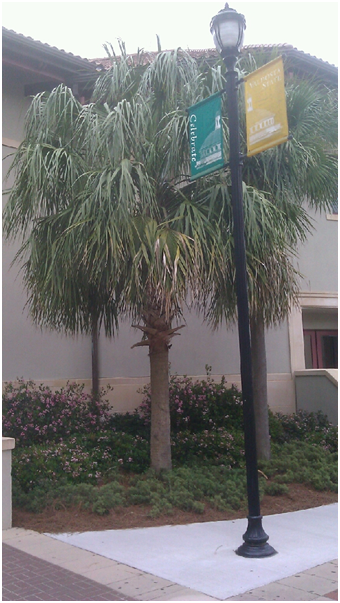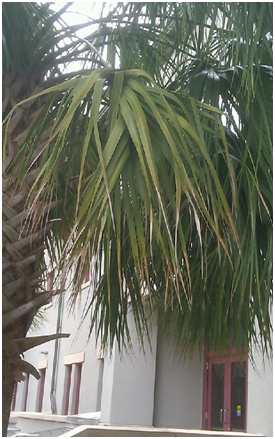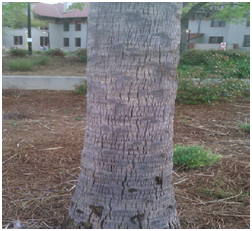Cabbage Palm
Sabal palmetto

(Photo by Marcel Smith)
View the Location on Campus
Taxonomy (1)
Classification: Angiosperm, monocot
Family: Arecaceae
Common name: Sabal palm, Cabbage palm
General Information (1)
Region of Origin: Southeastern United States, Cuba, Bahamas
USDA Plants Hardiness Zones: 8-10
Growth Habit: Tree, but not a true tree
- Size: 50-70 feet
- Fruiting: Late fall to early winter
Diagnostic Characteristics
Leaves (1)
- Other: Yellow-green to dull green in color, leaves are about 12 feet long

(Photo by Marcel Smith)
Stem/Bark (2)
- Other: No bark, becomes wider towards the top

(Photo by Marcel Smith)
Flower (1)
- Color: Creamy white
Fruit (1)
- Fruit type: Drupe
- Color: Purple to yellow
Horticultural Information (1,3)
- Light: Full sun to partial shade
- Maintenance: Easy to care for
- Landscape Uses: Beachside, ornamentals, and along streets
- Other: Salt and drought tolerant
Interesting Facts (2)
- The "heart" tastes like cabbage, but it kills the plant when it is removed
References
1) Scheper, J. (2004). Sabal palmetto. Floridata. April 1, 2013, from http://www.floridata.com/ref/s/sab_palm.cfm.
2) Stibolt, G. (n.d.). Palmettos in the Landscape. Floridata. April 1, 2013, from http://www.floridata.com/tracks/transplantedgardener/palmettos.cfm.
3) Butler, M. (n.d.). How to Prune a Sabal Palmetto. Ehow. April, 2, 2013, from http://www.ehow.com/how_10043087_prune-sabal-palmetto.html.
Edited by Jessica Bartek
Department of Biology
-
Room 2035, 2nd Floor
Bailey Science Building -
Mailing Address
1500 N. Patterson St.
Valdosta, GA 31698 - Phone: 229.333.5759
- Fax: 229.245.6585
Monday - Thursday
8:00AM until 5:30PM
Friday
8:00AM until 3:00PM
Saturday - Sunday
Office Closed